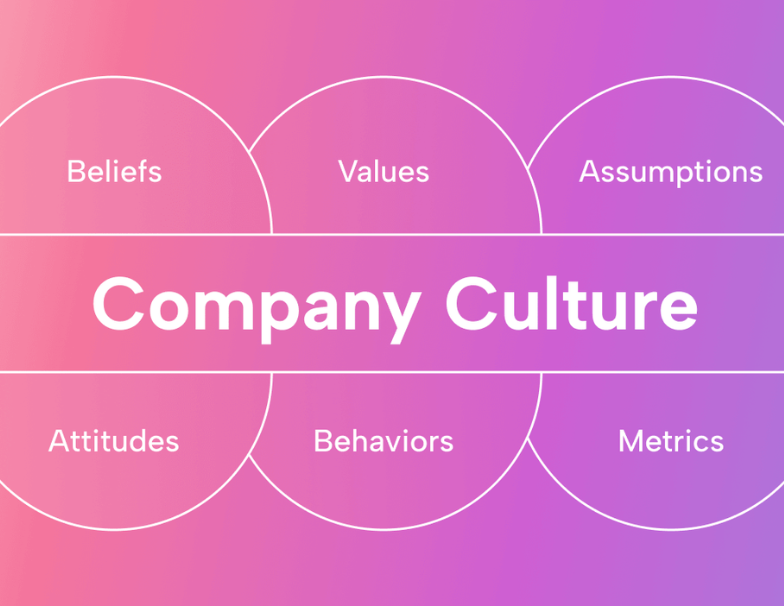Understanding Organizational Culture: Key Elements and Benefits

Organizational culture refers to the shared values, beliefs, and practices that shape how employees interact and work within a company. It’s crucial because it influences everything from employee satisfaction to business performance. This article will explore the key elements, types, and benefits of a strong organizational culture.
Key Takeaways
- Organizational culture, defined by shared values and practices, influences employee behavior and overall business performance.
- Four main types of organizational cultures—Clan, Adhocracy, Market, and Hierarchy—each offer unique advantages and challenges that affect workplace dynamics.
- Strong organizational culture enhances recruitment, boosts employee engagement, and drives overall business success, making leadership’s alignment and communication vital for cultural transformation.
Defining Organizational Culture

Organizational culture encompasses the shared values and attitudes within a company, including cultural values. It also includes the practices that contribute to shaping the company’s identity and corporate culture. It is how individuals within an organization relate to their work and to each other, characterized by shared beliefs, expectations, norms, and perspectives among members. This collective identity significantly influences employee behavior and interactions within the organization’s culture and the company’s culture.
A positive organizational culture promotes mutual respect and offers growth opportunities. It also cultivates shared goals, leading to an environment where employees can thrive. A healthy culture is built through consistent and authentic behaviors, reflecting the organization’s values and mission.
Deliberately shaping organizational culture is crucial for improving company culture and improving organizational culture and sustained success.
Types of Organizational Cultures

Organizational cultures come in various forms, each with its unique characteristics and influences. Organizational culture can be categorized into four main types:
- Clan
- Adhocracy
- Market
- Hierarchy
Each type presents unique advantages and challenges, influencing how an organization functions and interacts with its employees.
Clan culture focuses on employee welfare and personal problems, creating a supportive environment where collaboration and mentorship are key. Adhocracy culture, on the other hand, emphasizes innovation, encouraging employees to take risks and develop new ideas in a dynamic workplace.
Market culture prioritizes competition and profitability, often placing high pressure on performance. Lastly, hierarchy culture values structure, stability, and clear procedures, ensuring consistency and order.
Clan Culture
Clan culture is characterized by:
- A highly collaborative environment
- Employees seen as family members
- Emphasis on mentorship
- Focus on teamwork
- Strong relationships among employees
- Various clan cultures that enhance these characteristics
Clan culture exemplifies seamless collaboration and idea-sharing among team members, fostering a positive and engaging good company culture. As a vital team member, this approach enhances overall productivity.
Adhocracy Culture
Adhocracy culture focuses on risk-taking and innovation, promoting a dynamic and adaptable workplace. It encourages creativity, allowing new ideas to flourish and drive success. The phrase ‘Risk it for the biscuit’ encapsulates adhocracy culture, where taking chances is key to success.
Market Culture
Market culture is driven by competition, goals, and profitability. This culture focuses on external success, evaluating performance based on profitability and competitive edge. The motto ‘We’re in it to win it’ highlights market culture’s emphasis on achieving business ethics goals through relentless performance.
Hierarchy Culture
Hierarchy culture values structure, stability, and clear procedures. Its primary focus is on maintaining order and ensuring that tasks are completed correctly. The phrase ‘Get it done right’ reflects hierarchy culture’s emphasis on precision and reliability, ensuring clear direction and well-defined processes.
Importance of Organizational Culture

Organizational culture is a powerful force that impacts employee satisfaction, recruitment, retention, and overall business success. Focusing on relationships and community within a culture reduces job stress and enhances employee retention. This directly impacts the type of candidates attracted and retained, making it vital for talent management. Organizational culture influences investing in culture, strengthens relationships, improves retention, and fosters long-term success.
A robust organizational culture dictates business performance and influences organizational culture outcomes. Elements like organizational structure, leadership, mission, and strategy significantly shape culture, guiding employees through complex changes and fostering unity. Analyzing organizational culture helps predict employee satisfaction and commitment, making it crucial for business strategy.
Enhancing Employee Recruitment
A well-defined organizational culture and strong culture is a key differentiator in attracting and retaining talent, with many job seekers prioritizing great organizational culture over compensation when considering job opportunities. A strong organizational culture can greatly accelerate this process, particularly when it is both aligned with the company's current culture and intentionally oriented toward the ideal cultural framework the organization seeks to achieve.
Interview questions should assess the interviewee’s alignment with the company’s culture and values. Clearly defined and promoted core values foster unity and guide business decisions.
Boosting Employee Engagement and Retention
Positive workplace cultures are linked to significantly lower employee turnover rates. Engaged employees are less likely to leave their organization compared to disengaged ones. A supportive workplace culture enhances employee loyalty, morale, and overall productivity.
Leaders should ensure all employees understand how their roles contribute to broader organizational leadership goals within the entire organization, fostering employee commitment, engagement, and retention.
Driving Business Success
Organizations with a strong company culture tend to achieve higher profits and better financial returns. Positive workplace cultures often result in higher annual returns and increased profitability. In 2023, companies on the 2024 Fortune 100 Best Companies to Work For outperformed the market average by 3.68 times.
Cultivating a culture of continuous learning and innovation attracts top talent and creates a competitive advantage.
Leadership's Role in Shaping Organizational Culture

Leaders play a pivotal role in shaping organizational culture. They set expectations, model values, and influence cultural advocacy. When leaders do not embody the organization’s values, it undermines cultural efforts and leads to employee disillusionment. Contradictory behavior from leaders can create a mismatch in employee actions. Effective leaders foster a culture where employees align with the organization’s mission, directly influencing leadership influence organizational culture and cultural cohesion.
Unified leadership commitment is essential for successfully driving and sustaining cultural changes within an organization. Leadership alignment ensures a consistent message throughout the organization, establishing credibility in cultural change efforts.
Leading by Example
Leaders must embody the values and behaviors they wish to see in their teams, as company values shape employee work and collaboration, reflecting aspects of human behavior and developing essential leadership skills within the company leadership senior leadership team, including collective behaviors and leadership style.
Leaders should consistently evaluate whether their actions align with organizational values, significantly impacting team performance and culture.
Communicating Vision and Values
Effectively communicating vision and values aligns employees with the company’s mission and goals. Employees observe these values in action through HR policies, benefits, and initiatives.
Leadership’s communication fosters a culture aligned with core values, enhancing understanding and commitment.
Fostering a Positive Work Environment
Managers play a vital role in fostering a feedback culture in the workplace. As trusted coaches, they build stronger relationships with employees. A supportive work environment significantly enhances well-being and productivity, with increased managerial support leading to improved morale and overall performance.
Assessing Your Organizational Culture

Assessing organizational culture is key to understanding the current landscape and identifying areas for improvement. The Organizational Culture Assessment Instrument (OCAI) evaluates and enhances culture by providing clear insights into strengths and weaknesses through data collection from various sources.
Regular feedback mechanisms, like employee surveys, identify cultural issues and foster open communication. Cultural transformation requires a clear definition of the desired culture and consistent evaluation. Assessing culture involves comparing the current culture with the optimal one and measuring the gaps.
Organizational Culture Assessment Instrument
The Organizational Culture Assessment Instrument (OCAI) evaluates and enhances organizational culture by providing insights into strengths and weaknesses through data collection from various sources.
Utilizing the OCAI leads to a more aligned and effective organizational culture, enhancing overall performance.
Employee Feedback and Surveys
Pulse surveys and workplace chatbots effectively collect employee feedback. These tools capture real-time employee sentiments regarding culture, providing crucial insights into their perceptions and experiences within the organization.
Analyzing Results
Interpreting assessment data helps organizations understand their current cultural landscape and inform improvement strategies. Methods such as surveys, interviews, and observations gauge employee sentiments.
Utilizing specific tools like the OCAI helps identify strengths and areas in need of improvement.
Strategies to Improve Organizational Culture
Enhancing organizational culture creates a positive and productive work environment where employees feel valued and motivated. A supportive workplace culture is crucial for long-term success, fostering motivation, connection, and inspiration among employees.
Employee feedback is vital for gauging perceptions and driving effective cultural change. Timely analysis of feedback ensures quick implementation of actionable initiatives. Intentional actions engaging employees at all levels are necessary for cultural transformation.
Defining Core Values
Core values serve as a guiding compass for behavior and decision-making, reflecting the company’s core values. These values should be relatable and actionable for all employees.
Integrating values into everyday operations creates a workplace where purpose and practice align effectively.
Promoting Transparent Communication
Transparent communication within an organization increases employee trust and satisfaction. Practices like open-door policies, top-down communication, and dedicated meeting hours with leadership encourage open dialogue, fostering a positive culture and improving engagement.
Investing in Employee Development
Investing in employee development enhances job satisfaction and fosters loyalty. Effective methods include stipends for education, mentorship programs, and upskilling opportunities.
Adequate training and support resources mitigate resistance to new processes, ensuring employees feel prepared and confident.
Overcoming Challenges in Cultural Transformation
Cultural transformation is rarely smooth. Resistance, confusion, and misalignment can derail efforts. To change organizational culture and facilitate culture change, define and assess the current culture, set clear goals, and continually evaluate progress.
Implementing changes based on perceived culture without deeper analysis of actual culture often leads to failure.
Resistance to Change
Resistance to change is common during cultural transformation. Employee pushback can manifest as decreased productivity and increased turnover. Common forms of resistance include complaints, hostility, and public doubts about proposed changes.
Effective communication mitigates resistance by clarifying the reasons and benefits behind changes. Engaging employees in the process fosters acceptance and reduces opposition.
Aligning Leadership
Aligning leadership is crucial for shaping organizational culture. Leaders must model desired values and behaviors to align the workforce with cultural goals. Effective communication from leadership aligns employees with the company’s mission and vision, solidifying the cultural foundation.
A positive work environment encourages employee engagement and retention in a positive environment.
Measuring Progress
Measuring progress in cultural transformation ensures efforts are effective and align with desired outcomes. Evaluation methods include tools like the competing values framework and employee surveys.
Gathering insights directly from employees helps understand their perceptions and experiences, guiding cultural initiatives and ensuring continuous improvement.
Summary
Understanding and nurturing organizational culture is imperative for any organization aiming for long-term success. From defining and assessing culture to implementing strategies for improvement, each step plays a vital role in creating a positive and productive workplace. Leaders are instrumental in shaping and maintaining this culture by leading by example, communicating vision and values, and fostering a supportive environment.
Overcoming challenges in cultural transformation requires clear goals, alignment of leadership, and effective communication. Regular assessment and employee feedback are crucial for continuous improvement. By prioritizing organizational culture, companies can enhance employee satisfaction, retention, and overall business success.
FAQs
- What is organizational culture?
Organizational culture is the collective set of values, beliefs, and behaviors that define how members of an organization interact and work together. It fundamentally influences the overall identity and effectiveness of the company.
- Why is organizational culture important for recruitment?
Organizational culture is crucial for recruitment as it attracts and retains talent, with many job seekers valuing cultural fit even more than compensation. A strong culture can significantly enhance the quality of candidates applying for positions.
- How can leaders influence organizational culture?
Leaders significantly influence organizational culture by embodying core values, effectively communicating their vision, and creating a positive work environment. Their actions and behaviors ultimately establish the organizational tone and expectations.
- What tools are available for assessing organizational culture?
The Organizational Culture Assessment Instrument (OCAI) is a key tool for evaluating and enhancing organizational culture, offering insights into both strengths and weaknesses. Utilizing such tools can lead to a deeper understanding and improvement of your workplace culture.
You may also like
Unique spaces for your next offsite
Find distinctive venues for your upcoming corporate retreat.
Stay Updated with Our Insights
Get exclusive content and valuable updates directly to you.







